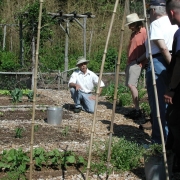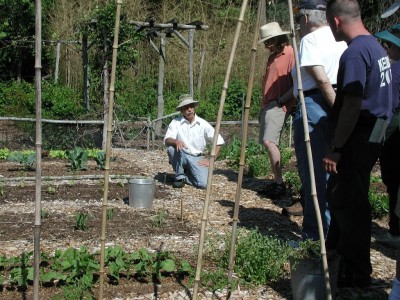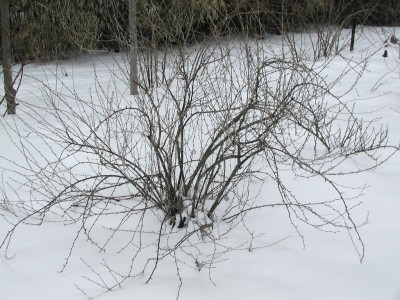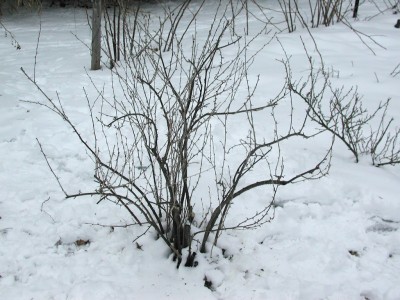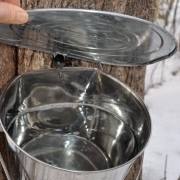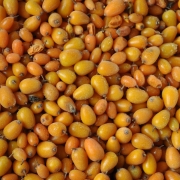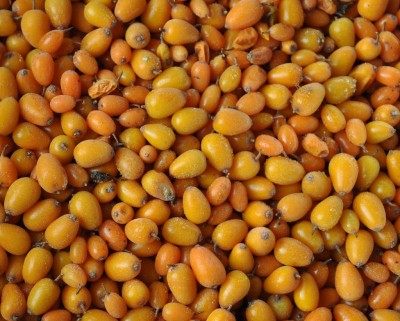PRUNING WORKSHOP, April 3rd, at my garden!!
Contact me thru my website for more details.
———————————–
Summer cole slaws, steaming plates of broccoli, and kale cooked and drizzled with some olive oil, lemon juice, and toasted sesame seeds are now on their way. Seeds are sown, sprouts should be up within a few days, and a few days after that I’ll lift enough sprouts from their mini-furrows in a seed flat to fill a 40 cell tray. By May 1st, the seedlings will be big enough and will be planted out in the garden.
An early start is important with most of these plants in the cabbage family, the so-called cole crops, or crucifers. (“Crucifer” because everyone in the family bears 4-petalled, cross – “cruc” – shaped flowers.) These are plants that thrive in and taste best with cool, moist weather. The one exception is kale, which to me has a rich, sweetish, nourishing flavor even in the heat of summer. I see some still out in the garden now that the snow is receding, and will harvest it the first chance I can get through the garden gate, which, as I write, is still locked close with snow.
The cabbages and broccolis I just sowed are for early summer; the kale for spring, summer, fall, and, as long as I can get to it, winter. Fortunately, I grow backup kale, a dozen plants that enjoy the cool temperatures of the greenhouse all winter long.
Kale for this year is Dwarf Blue Scotch and Winterbor. For cabbage, I’m growing the tasty, small and pointy-headed, heirloom variety Early Jersey Wakefield. With broccoli, I’m hedging my bets. I bought a packet of mixed seed, including varieties with different harvest times, some notable for making large main head, and some notable for prolific side shoots.
——————————————————–
Receding snow makes it easier to get to some low bushes and see what to prune. Like my currant and gooseberry bushes, which will be the first to get pruned. The reason they are first in line is because they are the first to begin growing. A few days of warm weather and their buds will all of a sudden turn green with nascent leaves about to unfold.
I prune most of these plants by a renewal method. Being shrubs, they’re always sending new sprouts, called suckers, up from ground level. Old stems do not stay virile very long, typically not bearing well after about 3 years. With renewal pruning, all stems more than 3 years old get lopped back to ground level or to low-growing vigorous, upright side branches. The stems that are the oldest are obvious because they are fattest and have the peelingest bark.
Next, I turn to the suckers. Each year, these bushes typically send up a lot of new suckers from ground level, too many, so many that they would crowd each other with age. So the other pruning needed is to reduce the number of new suckers to a half-dozen or so, saving those that are most vigorous, healthy, and upright. Finally, I shorten lanky stems that would otherwise droop to the ground, especially when loaded with a crop of berries.
What’s left after pruning, then, are a half-dozen new suckers, a half-dozen 1-year-old stems left from last year, a half-dozen 2-year-old stems form the year before last, and a half-dozen 3-year-old stems from the year before that. That’s about how the bush looks every year after being pruned, in theory, at least. Nothing’s too old and the young ‘uns have room to grow.
Pruning gooseberries is a thorny affair that demands use of leather gloves.
———————————————————–
Most people on this side of the Atlantic (excepting Canada) don’t really know gooseberries. If they’ve experienced the fruit, they consider them all to be small, green, and tart, which, unfortunately, those most commonly offered are. In fact, gooseberries come in a wide spectrum of flavors, colors, and size.
For starters, and most importantly, gooseberries can be divided into culinary and dessert varieties. Many dessert varieties can be used for cooking, for which use they’re harvested slightly underripe.
Dessert varieties have a sweet or sweet-tart flavor. My Hinnonmakis Yellow berries are small, yellow, and sweetly reminiscent of apricot. Black Satin gooseberries are wine-red in color with a flavor much like a sweet, rich wine. Colossal, which I’ll be planting again after a 15 year hiatus, has humongous fruits with a cracking texture: the skin is firm but explodes into your mouth with an ambrosial, sweet juice when you bite into it.
Generally, gooseberries are tough plants that are easy to grow. They’ll tolerate any amount of cold and deer leave them alone. I’m looking forward to enjoying fruits of the dozen varieties I grow in July.
[carnations]
/1 Comment/in Gardening/by Lee A. Reich Don’t be surprised if you see me sporting a pink carnation in my buttonhole this summer. I want big, fat, fragrant, florists’ carnations, and I think I finally found one: Enfant de Nice. I’ve grown many “pinks,” another name for carnations, in the past, but they were always too demur. Enfant de Nice, from its descriptions, should have corpulent blooms in white and various shades of pastel pink. The fragrance, billed as “intoxicating spicy-sweet clove perfume,” sounds heady enough that it might have me unable to walk a straight line with one of those in my buttonhole.
For now, the practical must be dealt with: sowing seeds 1/2 inch deep in seed flats kept cool and moist, then moving sprouted seedlings to individual cells, and finally, after the last average frost date (mid-May), out to the garden. Pruning back stems after blossoming should keep me in boutonnières through July and August.
————————————————————
I just checked my maple syrup buckets. They were all full.
[seaberry, wheat, spring indoors]
/0 Comments/in Gardening/by Lee A. Reich The garden is winding down so I’ll look into the freezer and see what I’ve got. Hmmmm. A couple of jars of frozen, small, yellow-orange berries. Sea berries! I forgot all about them. I’ve had the bushes for a few years and each year nibble a few of the tart berries. This year I decided to use the berries in earnest.
Native to Russia, China, and northern Europe, sea berries are relative newcomers to this part of the world. And even then, they’re often planted strictly as ornamental shrubs. Their silvery leaves make the perfect backdrop for their bright and abundant orange, yellow, or red berries. As a fruiting or ornamental plant, sea berry is easy to grow, needing only abundant sunlight and well drained soil. A (nonfruiting) male plant is needed to get fruit on nearby female plants; each male can sire up to 8 females.
Years ago someone sent me some sea berry juice, the flavor of which was something like very rich orange and passionfruit juices. Some people liken the flavor to pineapple; hence “Siberian pineapple,” another common name for the fruit.
The reason I only nibbled on sea berries up to this year is because harvesting the small berries can be a problem. They press closely to the stems, and the stems are armed with intimidating thorns. Someone suggested freezing the branches and then shaking off the frozen berries. That’s what I tried back in September, cutting berry-laden branches into foot long sections and and putting them in a large, plastic tub with a tightly fitting lid. Once everything was well frozen, I shook the tub with the lid still on. A lot. The berries fell off and settled to the bottom of the tub and after winnowing what was left in front of a fan outdoors, I had a couple of quarts of clean berries.

The fruit allegedly makes excellent sauces, syrups, and jellies; my plan was to replicate that delicious Siberian pineapple juice. After heating the berries in a saucepan with a bit of water, mashing them with a potato masher, and straining, I had 3 cups of a beautiful, but nose wrinkling, tart, juice. I added about a half a cup of water along with a half a cup of sugar, mixed well, and was ready to try out the juice on some dinner guests. Served before dinner in apéritif glasses, the juice was a hit. Everyone asked for more.
—————————————————————–
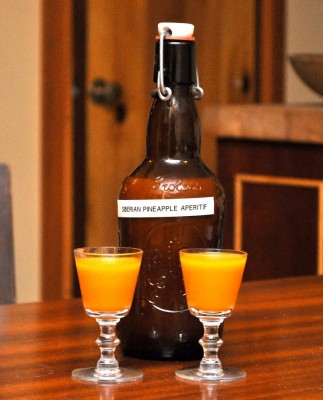 I next turned to the bowl of tawny stems and grains that’s been sitting on the kitchen table for a couple of months. That bowl represented the sum total of my wheat harvest, planted in spring into 3’ by 3’ of garden bed.
I next turned to the bowl of tawny stems and grains that’s been sitting on the kitchen table for a couple of months. That bowl represented the sum total of my wheat harvest, planted in spring into 3’ by 3’ of garden bed.The cut stalks of wheat, with their fat heads of dry grain, had been hanging upside down from the kitchen ceiling up to a few weeks ago. The contents of the bowl — chaff, grain, and bits of stalk — represented the results of putting the stalks into a pillowcase and beating them up vigorously, and then removing long stems remaining. That was a couple of months ago.
Yesterday, as long as I had my winnowing fan set up outdoors for the sea berries, I thought I might as well also winnow the wheat grains. As with the sea berries, slowly pouring the grains and other debris in front of the fan sent most of the debris flying away, leaving with the crop, the grain in this case, settling into a waiting bowl below.
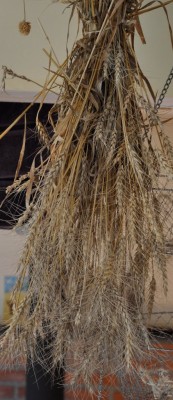
My crop was relatively paltry, about a half a cup of grain. This half a cup per 9 square feet translates to about 16 bushels per acre. Average wheat yields are 30 to 50 bushels per acre, with some farmers harvesting over 100 bushels per acre. I guess I’m not much of a wheat grower — yet. I’ll try again next year, perhaps planting more densely or earlier.
——————————————————————-
With the shortest day of the year past, it’s time for hints of the sights and smells of spring — indoors. Paperwhite narcissus, potted up back in November, is already blooming and perfuming the air. And I’ve brought up a jasmine plant (poet’s jasmine, Jasminium officinale) from the basement. That jasmine plant, along with a few others, was outdoors this past fall through a few light frosts, then has sat in front of a sunny window in my cool basement. The cool temperatures, perhaps also short days and occasionally dry soil will contribute to abundant bloom in weeks ahead. I’ll extend the bloom by bringing up a new jasmine plant every few weeks.

